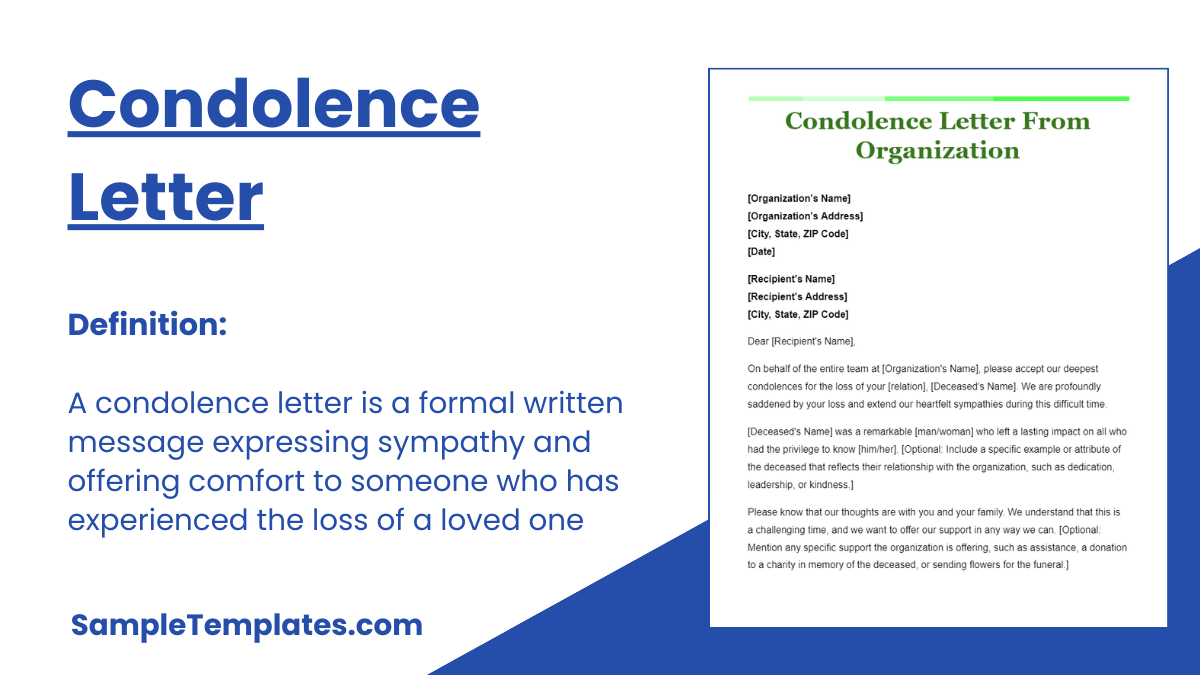Sometimes typing out condolence letters for acquaintances, employees and business clients can not only be time consuming, they can also be extremely awkward. So to save your day, here are a few most popular, best Professional Letters which you can morph to suit your requirements. The names can be replaced or filled in, the details edited and your signature added before sending them by direct email.
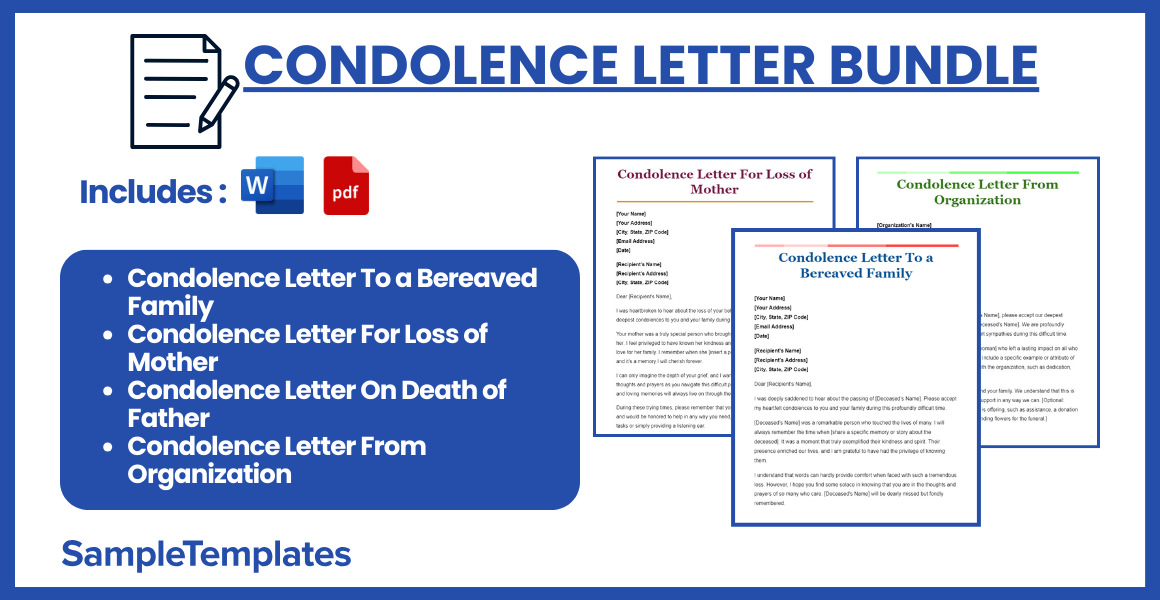
Download Condolence Letter Bundle
Condolence Letter To a Bereaved Family
[Your Name]
[Your Address]
[City, State, ZIP Code]
[Email Address]
[Date]
[Recipient’s Name]
[Recipient’s Address]
[City, State, ZIP Code]
Dear [Recipient’s Name],
I was deeply saddened to hear about the passing of [Deceased’s Name]. Please accept my heartfelt condolences to you and your family during this profoundly difficult time.
[Deceased’s Name] was a remarkable person who touched the lives of many. I will always remember the time when [share a specific memory or story about the deceased]. It was a moment that truly exemplified their kindness and spirit. Their presence enriched our lives, and I am grateful to have had the privilege of knowing them.
I understand that words can hardly provide comfort when faced with such a tremendous loss. However, I hope you find some solace in knowing that you are in the thoughts and prayers of so many who care. [Deceased’s Name] will be dearly missed but fondly remembered.
During this challenging time, please know that I am here for you. If there’s anything that I can do to assist you or your family—from helping with errands to simply lending an ear—please do not hesitate to reach out.
Once again, I extend my deepest sympathies to you and your loved ones. May you find peace and comfort in the memories you cherished together.
With heartfelt condolences,
[Your Name]
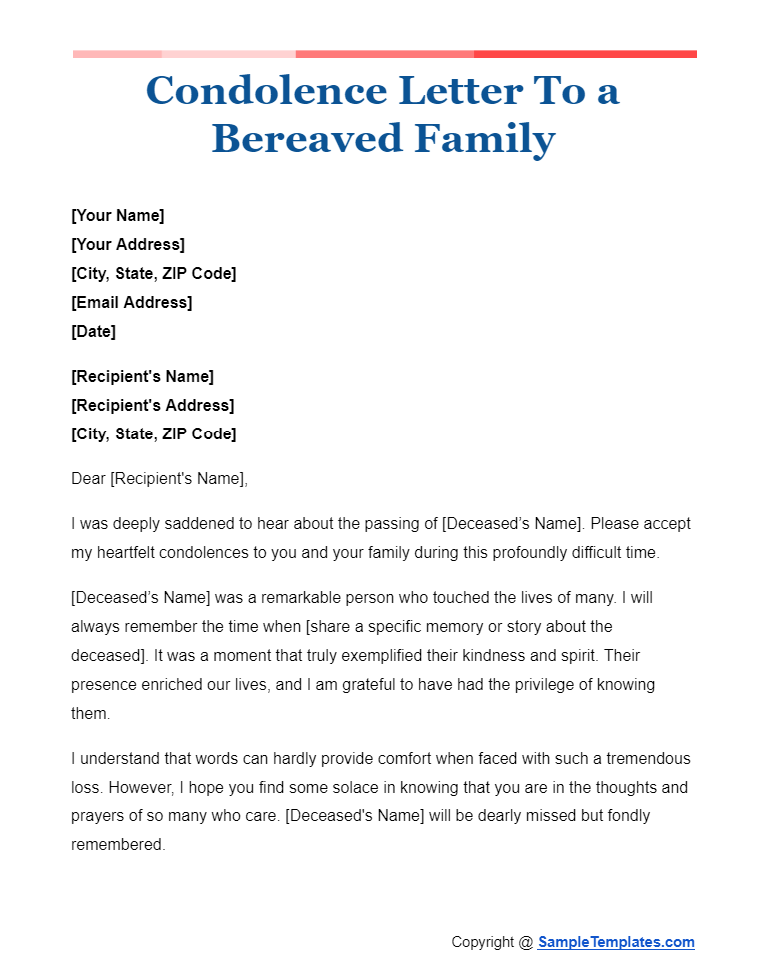
Condolence Letter For Loss of Mother
[Your Name]
[Your Address]
[City, State, ZIP Code]
[Email Address]
[Date]
[Recipient’s Name]
[Recipient’s Address]
[City, State, ZIP Code]
Dear [Recipient’s Name],
I was heartbroken to hear about the loss of your beloved mother. Please accept my deepest condolences to you and your family during this sorrowful time.
Your mother was a truly special person who brought joy and warmth to all who knew her. I feel privileged to have known her kindness and to have witnessed her profound love for her family. I remember when she [insert a personal memory or anecdote here], and it’s a memory I will cherish forever.
I can only imagine the depth of your grief, and I want you to know that you are in my thoughts and prayers as you navigate this difficult period. Your mother’s wonderful spirit and loving memories will always live on through the many lives she touched.
During these trying times, please remember that you are not alone. I am here for you and would be honored to help in any way you need, whether it’s handling day-to-day tasks or simply providing a listening ear.
May you find some comfort in the love of those around you and the cherished memories you hold of your mother. If there is anything I can do for you, please do not hesitate to reach out.
With heartfelt sympathy,
[Your Name]
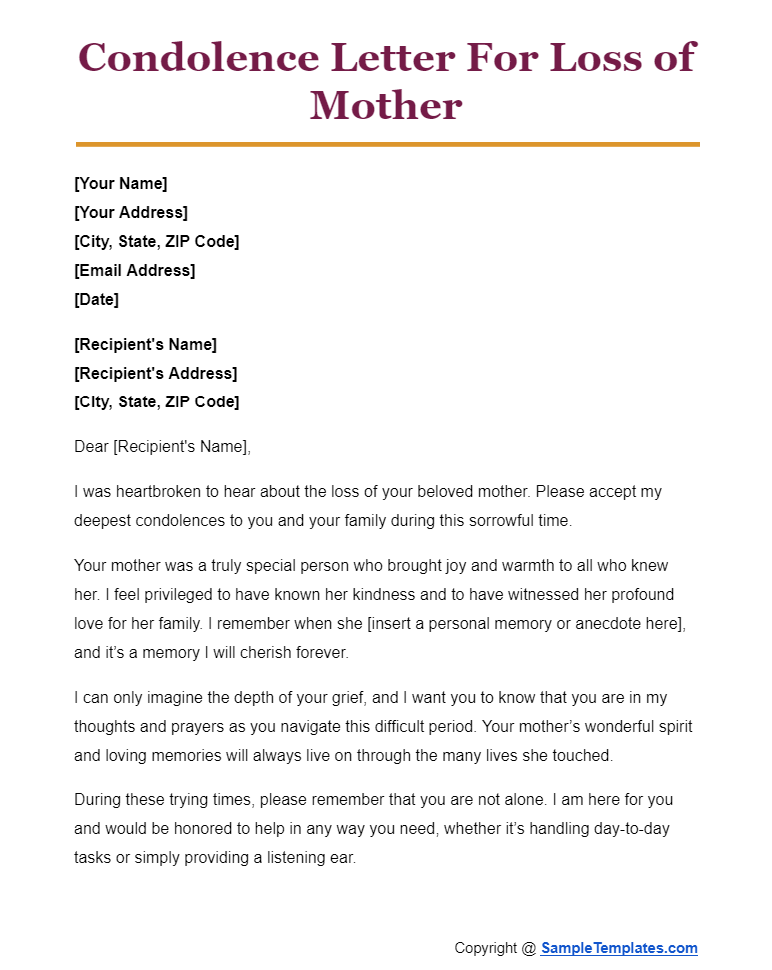
Condolence Letter On Death of Father
[Your Name]
[Your Address]
[City, State, ZIP Code]
[Email Address]
[Date]
[Recipient’s Name]
[Recipient’s Address]
[City, State, ZIP Code]
Dear [Recipient’s Name],
I was deeply saddened to hear about the passing of your father. Please accept my heartfelt condolences and know that my thoughts are with you and your family during this incredibly difficult time.
Your father was a remarkable person, admired by all who knew him for his integrity and kindness. I feel fortunate to have known him and will always remember his willingness to help others and his powerful sense of humor. It was always apparent how much he cherished his family, and I know his absence will be deeply felt by many.
Losing a father is profoundly challenging, and I can only imagine the sorrow you must be feeling right now. As you grieve, please remember that you are not alone. I am here for you, and if there is anything you need—be it running errands, helping with family arrangements, or simply a person to talk to—I am just a phone call away.
In the days to come, may you find comfort in the wonderful memories you shared and the love he had for you. Your father’s legacy is evident in the way you carry yourself with strength and kindness.
Once again, please know that I offer my loving condolences. I am here for you and your family during this mourning period, and I offer my support in whatever way you might need.
With deepest sympathy,
[Your Name]
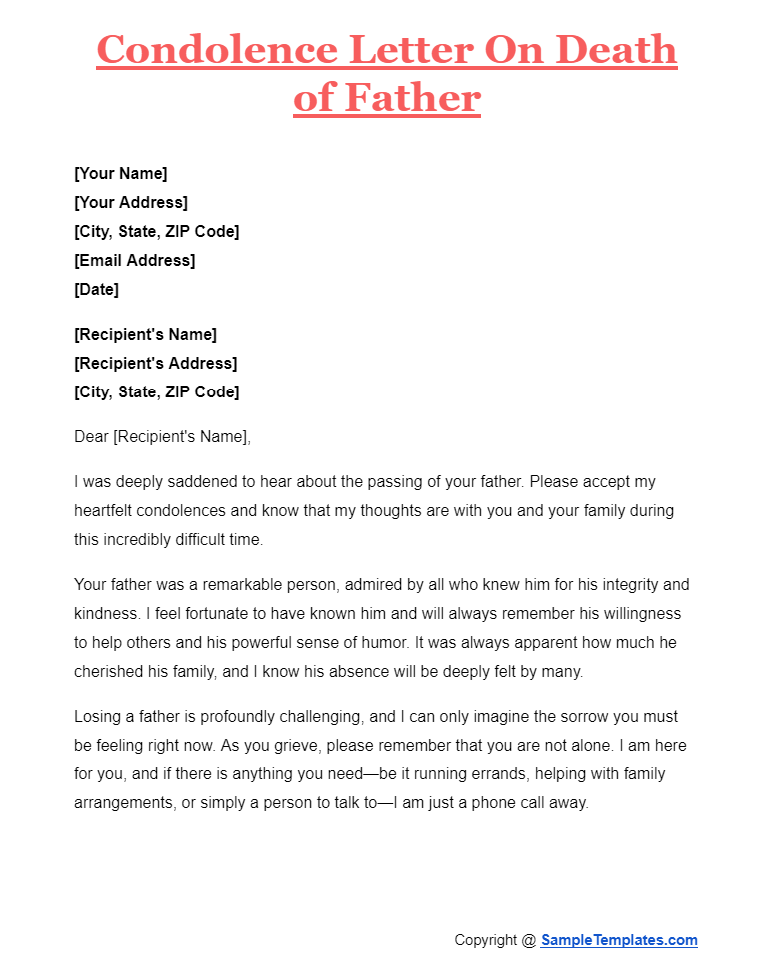
Condolence Letter From Organization
[Organization’s Name]
[Organization’s Address]
[City, State, ZIP Code]
[Date]
[Recipient’s Name]
[Recipient’s Address]
[City, State, ZIP Code]
Dear [Recipient’s Name],
On behalf of the entire team at [Organization’s Name], please accept our deepest condolences for the loss of your [relation], [Deceased’s Name]. We are profoundly saddened by your loss and extend our heartfelt sympathies during this difficult time.
[Deceased’s Name] was a remarkable [man/woman] who left a lasting impact on all who had the privilege to know [him/her]. [Optional: Include a specific example or attribute of the deceased that reflects their relationship with the organization, such as dedication, leadership, or kindness.]
Please know that our thoughts are with you and your family. We understand that this is a challenging time, and we want to offer our support in any way we can. [Optional: Mention any specific support the organization is offering, such as assistance, a donation to a charity in memory of the deceased, or sending flowers for the funeral.]
We join you in honoring the memory of [Deceased’s Name] and celebrating [his/her] life. [He/She] will be greatly missed by everyone here at [Organization’s Name].
Once again, please accept our sincerest condolences. If there is anything more we can do to assist you during this time, do not hesitate to reach out to us.
With deepest sympathy,
[Your Name]
[Your Position]
[Organization’s Name]
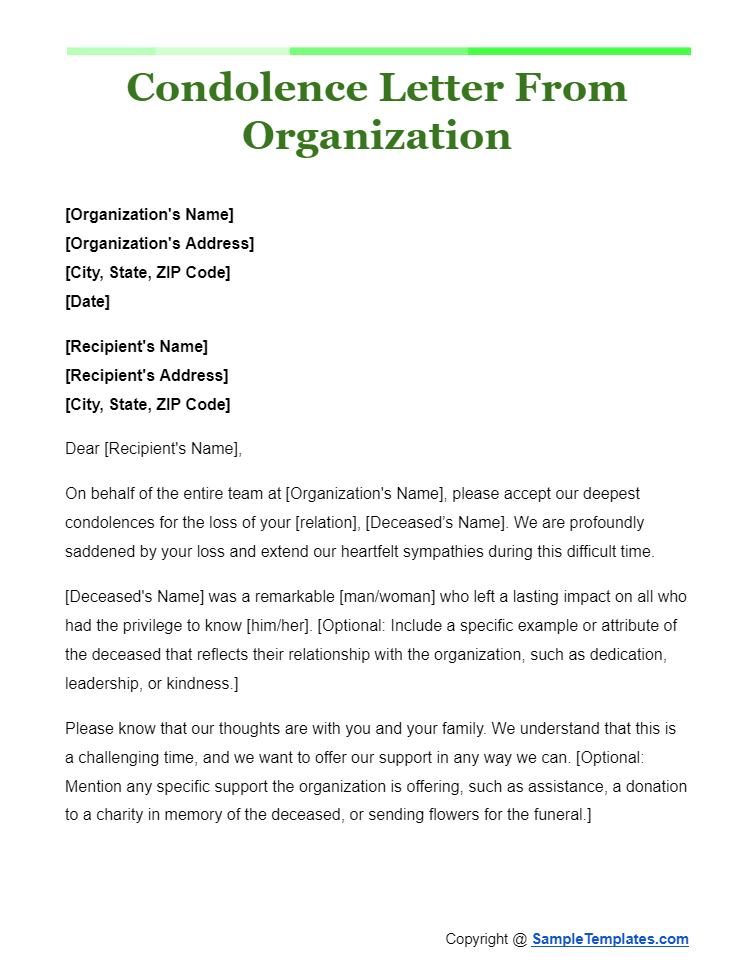
Browse More Templates On Useful Condolence Letter
Condolence Letter to a Friend
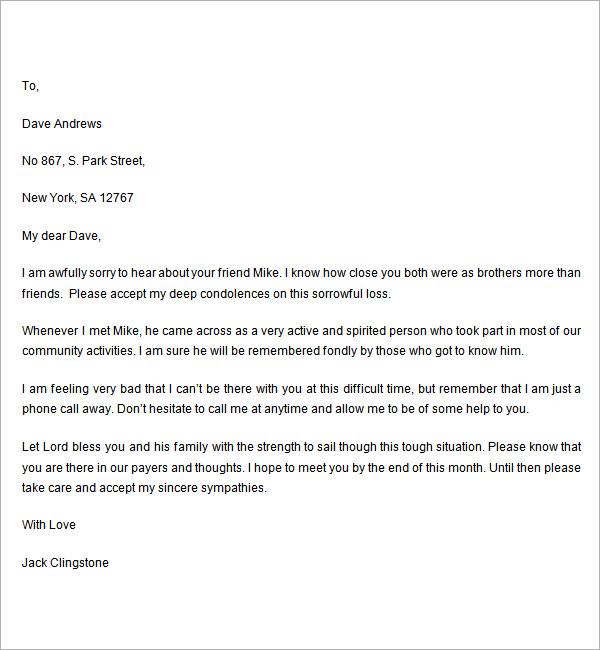
Writing a simple letter would have been a really difficult as well as a time consuming task. Therefore one must practice hard to have a proper layout and a structured format of the latter to be written. With the help of the Condolence Letter to a Friend one can easily frame a proper letter by making it apt for the situation.
Condolence Letter Death
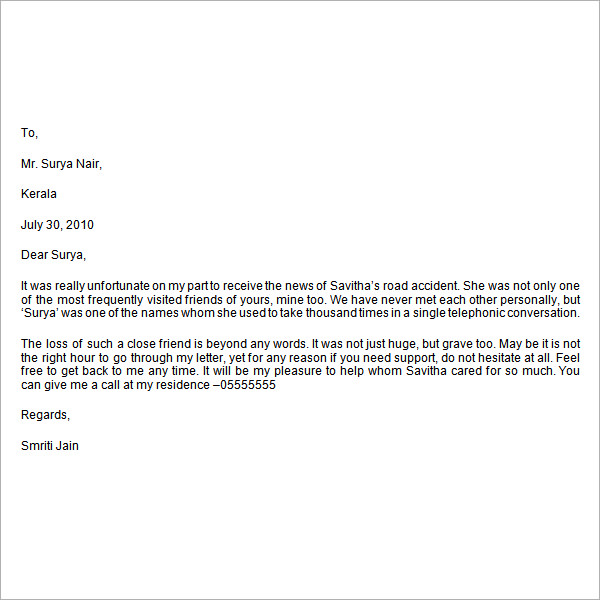
It is obvious that people who live far away might not able to meet much often and in that case if death occurs to someone, one can write a letter for condolence. A Condolence Letter Death template would help to frame a letter which includes the structure that fits apt for writing a letter to feel sorry for the death.
How to Write a Condolence Letter
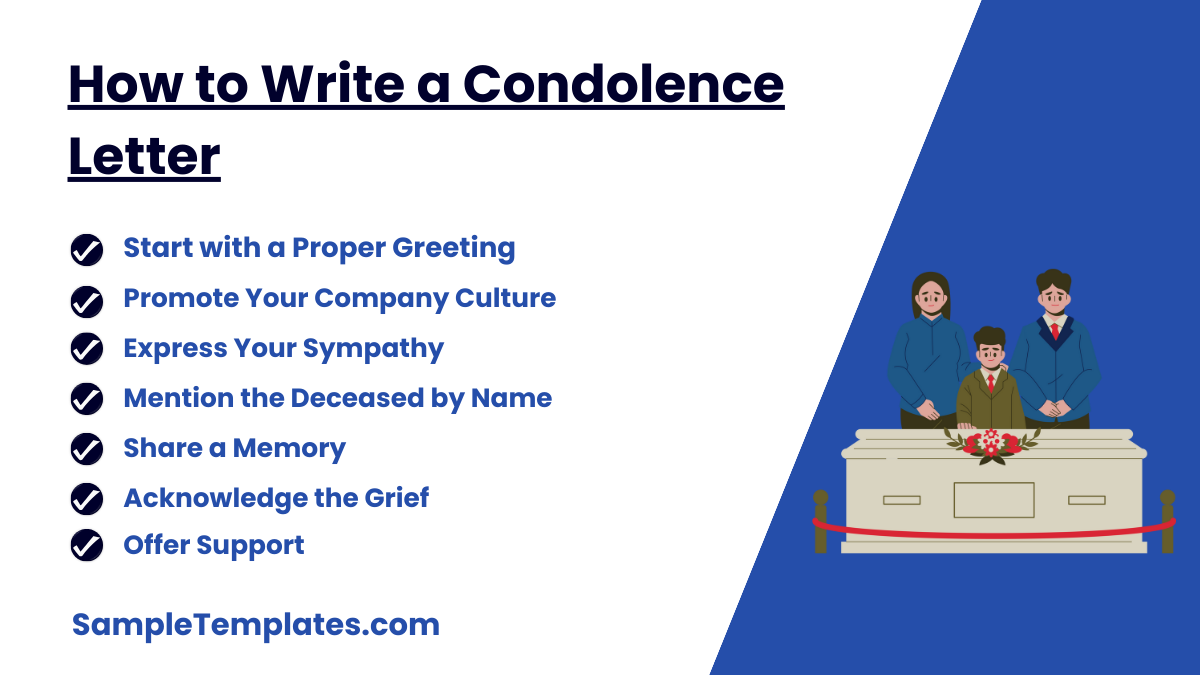
Writing a condolence letter is a thoughtful way to express sympathy and support to someone who is grieving. Here are some steps and tips to help you write a meaningful condolence letter:
1. Start with a Proper Greeting
- Address the recipient warmly and personally. Use their name and a suitable salutation like “Dear [Name],”
2. Express Your Sympathy
- Begin the letter by directly expressing your sympathy. Avoid clichés and try to make your sentiments genuine and heartfelt. For example, “I was heartbroken to hear of your loss.”
3. Mention the Deceased by Name
- Include the name of the deceased in your letter. This personalizes your message and shows that you care about the person who passed away.
4. Share a Memory
- If you knew the deceased, sharing a personal memory can be very comforting to the bereaved. It shows that their loved one left a positive mark on the lives of others.
5. Acknowledge the Grief
- Recognize that the recipient is going through a difficult time. Acknowledge their pain and the challenge of coping with the loss.
6. Offer Support
- Extend an offer of support, but be specific. Instead of saying “let me know if you need anything,” offer specific forms of help, like bringing meals, handling errands, or just being there to listen.
7. Close with a Thoughtful Conclusion
- Conclude your sample letter by reiterating your sympathy and support. Close with a warm and respectful sign-off, such as “With heartfelt sympathy,” or “With all my love and condolences,” followed by your name.
8. Keep It Brief and Respectful
- A condolence letter does not need to be long. A few sincere paragraphs are often more impactful than a lengthy letter.
Formal Condolence Letter
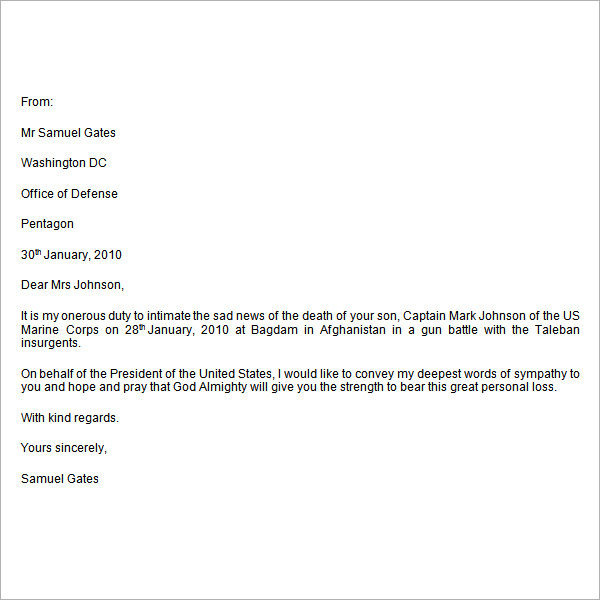
It has been really necessary to keep in mind that writing a letter is not easy but rather time consuming. It takes much time to frame an informal letter therefore writing a Formal Condolence Letter would rather be tough. With the help of the template one can easily frame a well versed letter with proper detailing and format.
Corporate Condolence Letter Sample
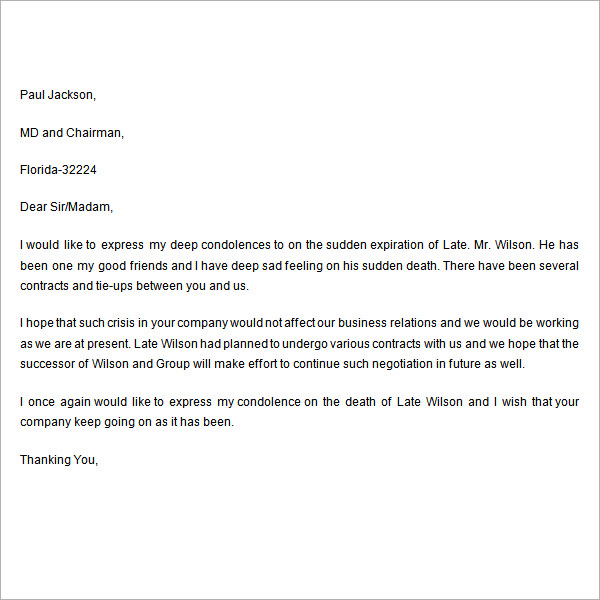
Writing a letter outline is a huge task and writing a letter for condolence is rather a tough job. Writing letter for the first time it really becomes confusing of what to include and what not to, therefore one can easily write a Corporate Condolence Letter with the help of the Corporate Condolence Letter Sample template. All you need is to rewrite the words and place them as it is in the letter.
Sales Condolence Letter
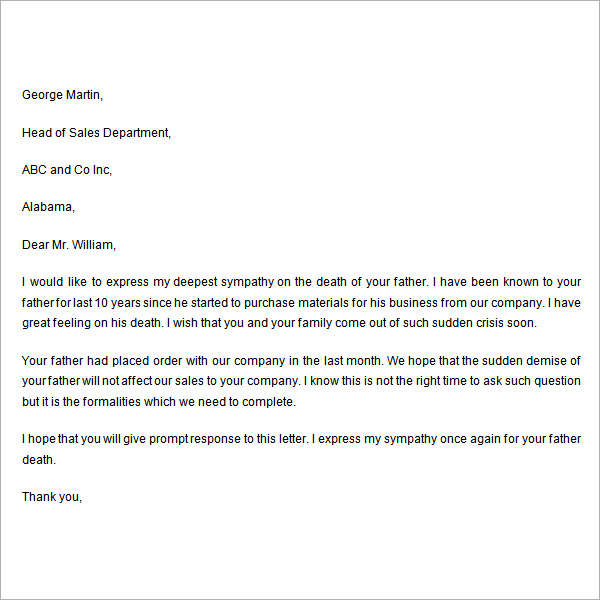
Tips For Writing a Condolence Letter

Writing a condolence letter layout is a delicate task that requires sensitivity and sincerity. Here are some tips to help you write a condolence letter that is heartfelt and supportive:
- Be Genuine: Express your feelings honestly. It’s important that your words convey genuine sympathy and empathy. Avoid overly formal or clichéd language that might seem insincere.
- Personalize Your Message: Mention the deceased by name and refer to the person you are writing to in a personal way. If you had a personal relationship with the deceased, share a fond memory or a story that highlights positive traits or moments.
- Keep It Simple and Direct: A concise and straightforward message often has the most impact. Express your sympathy clearly and avoid overly complex or elaborate language.
- Offer Specific Help: Instead of vague offers of help, provide specific suggestions on how you can assist. This might be running errands, bringing meals, helping with funeral arrangements, or just being there to listen.
- Acknowledge the Loss: Recognize the loss and the pain that the bereaved is experiencing. However, avoid assuming you know exactly how they feel—everyone’s grief is personal.
- Be Careful With Religious References: Unless you are certain of the bereaved’s religious beliefs, it’s best to keep religious references to a minimum or use them cautiously. Phrases like “They are in a better place now” can be comforting to some but upsetting to others.
- Close Thoughtfully: End your letter on a warm, compassionate note. Reaffirm your sympathy and support. A closing such as “With deepest sympathy” or “With heartfelt condolences” followed by your name is appropriate.
- Review Before Sending: Double-check your letter for tone and content. Make sure it is free from anything that might be misconstrued or might seem insensitive.
- Use Quality Stationery: If possible, use good quality paper and take the time to handwrite your letter. This shows that you care enough to put personal effort into your condolence message.
- Timing is Important: Send your condolence letter soon after you hear of the death, ideally within the first two weeks. Promptness in sending your message shows that you are attentive and truly concerned.
Following these tips can help you write a condolence letter that effectively communicates your sympathy and support during a difficult time.
General Condolence Letter Sample

Condolence Letter to Boss
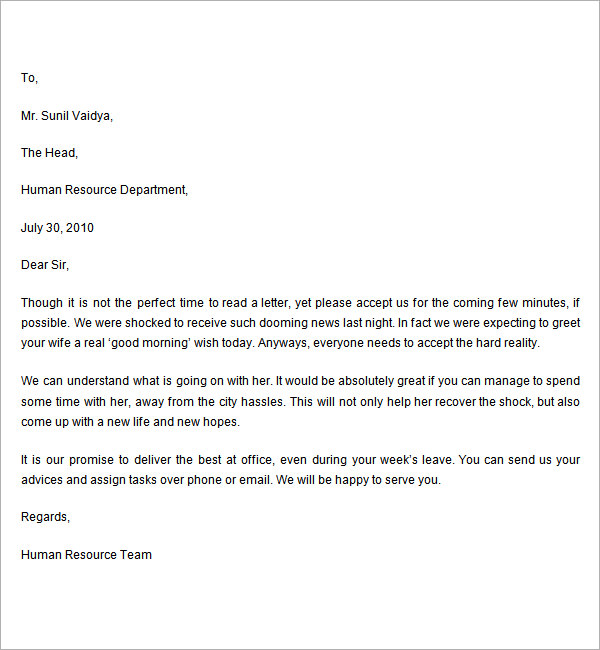
General Condolence Letter
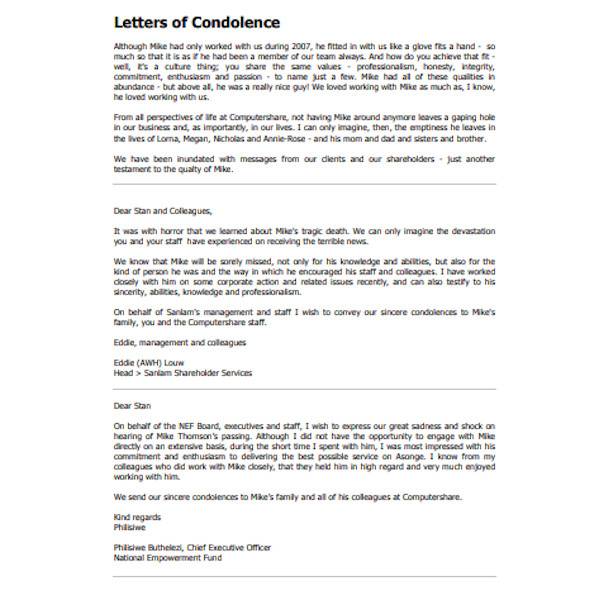
Why Does one Need a Condolence Letter Template?
Writing Formal Letters have been really tough job. It is time consuming and till date there are many people who get confused to frame a letter in a proper format and to the subject allocation too. However letters are the only way to keep things formal and also apt.
Therefore if one needs to figure out the correct format of framing the letter it would be really helpful for them to choose the condolence letter template that will guide them to write the letter correctly.
When Does one Need a Condolence Letter Template?
Sudden events like death and birth have no specific time to occur. Even like death are most certain and sudden therefore it can be to anyone whether for a corporate sector, business or school. Writing a letter of condolence is the first perfect way to screening the formal step to pay a sorry.
Writing letters is really a tough job and therefore not everyone knows how to frame proper structure but with the help of the condolence letter format template one can easily start writing letter in a proper structure and format which can later on be changed according to the events. You may also like Professional Letters.
Benefits of Condolence Letter
Writing a condolence letter offers several significant benefits, both to the sender and the recipient. Here are some key advantages:
- Expressing Empathy and Support: A condolence letter provides a way to express genuine sympathy and support to someone who is grieving. It lets the recipient know they are not alone during their difficult time, which can be immensely comforting.
- Creating a Lasting Memory: Unlike verbal expressions of sympathy, a letter is tangible. The recipient can keep it and revisit the comforting words whenever they need solace, making it a lasting token of support and empathy.
- Personal Connection: In today’s digital age, a handwritten letter can feel particularly personal and thoughtful. It shows the recipient that the sender took the time and effort to sit down and write, which can be perceived as a significant act of kindness.
- Providing Closure: For the sender, writing a condolence letter can also be a way to process their own feelings of grief and loss. It helps in acknowledging the loss, reflecting on the relationship with the deceased, and expressing emotions that might be difficult to share verbally.
- Offering Specific Comfort: A letter allows you to share specific memories and qualities of the deceased, which can be comforting to the bereaved by reminding them of the joy and love the deceased brought into their lives.
- Flexibility in Communication: Writing a basic letter gives you the time to carefully choose your words, ensuring that your message is clear and thoughtful. It also allows the recipient to read and respond in their own time, which is particularly important during a period of mourning when they might feel overwhelmed.
- Initiating Continual Support: A condolence letter can open the door for ongoing communication and support, letting the bereaved person know that you are there for them not just immediately after the loss, but in the future as well.
These benefits highlight why condolence letters have been a long-standing tradition in many cultures, serving as a meaningful way to communicate sympathy and support during times of grief.
Freedom of Formatting and Usage
You can find most of the condolence letters in the form of PDFs and sometimes in Word Doc formats as well. So it is evident that they are amicable towards formatting and other manipulations. You can add your own letter head, company logo (for a very formal letter on behalf of your organization) and your signature.
You can then print them on letter heads or normal papers as per requirements. Some of the premium versions of these Letters of Support templates also come complete with envelope formats to go with the theme of these letters. You can also see Notify Letters.
Salient Features of the Best Condolence Letter Templates
If you are still in two minds about downloading and using one of the samples, let us give you a few irrefutable reasons as to why you must do so
- These letters can be addressed to employees, family members, business acquaintances, friends etc.
- There are more condolence letter templates which can be used for announcing the demise of a family member or even send out obituaries.
- From formal to completely informal tones and purposes, these templates cover them all.
- They can also be edited to suit occasions to send out get-well-soon messages to formal relations.
With the help of the condolence letter template one can easily have a proper structure of writing a letter which reduces to lessen the time as well as the person can write a letter stating the purpose. All it takes is just a template for you to guide with the proper detailing of the events.
What do you say in a letter of condolence?
Express heartfelt sympathy, mention the deceased by name, share a personal memory, offer specific support, and close with words affirming your thoughts and support.
What not to say in a condolence letter?
Avoid clichés like “They’re in a better place” or minimizing the loss with “At least they lived a long life.” Stay clear of implying you know exactly how they feel.
What to say to the family when someone dies?
Express your sympathy with “I’m deeply sorry for your loss,” share fond memories if appropriate, offer specific help, and affirm your support and availability during their time of grief.
What is a polite response to condolences?
A simple “Thank you for your kind words and support during this difficult time” acknowledges the comfort and thoughtfulness others have offered.
Why not say sorry for your loss?
“Sorry for your loss” can sometimes feel generic or insincere. It’s often more meaningful to share specific sentiments or memories that show a deeper personal connection and understanding.
If you have any DMCA issues on this post, please contact us!
Related Posts
Sample Teaching Cover Letter Templates
Invitation Letters For US Visa Sample & Template
Sample Apology Letters For Being Late
Bank Authorization Letter Sample & Templates
Guarantee Letter Samples
Sample Letter of Interests
Sample Formal Business Letters Formats
Passport Authorization Letter Templates
Court Character Reference Letter Samples & Templates
Financial Aid Appeal Letter Templates
Sample Letter of Explanation
Sample Sponsor Thank You Letter Templates
School Excuse Letter Samples & Templates
Sample Closing Business Letter Templates
Self-Introduction Letter Samples and Templates
